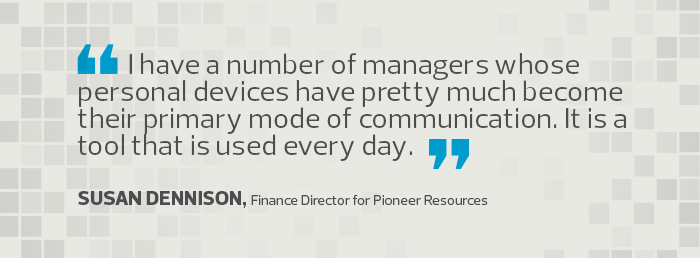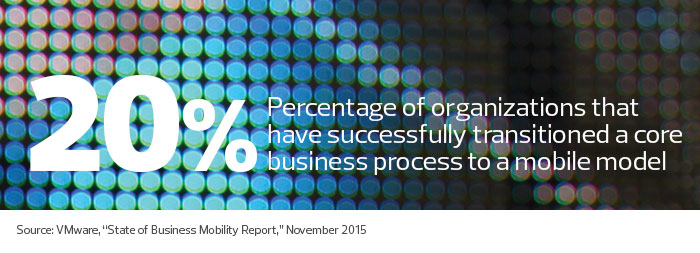5 Lessons for Successful BYOD Deployments
For employees at the South Dakota digital signage company Daktronics, working on the go was, until recently, a bit of a chore.
It was quite typical for employees to carry 5-pound, corporate-issued notebooks, along with 7-pound power supplies. Even if they decided that it was worth it to lug all of that equipment with them, workers often became frustrated because a slow virtual private network connection then hampered productivity.
“When people got a corporate-issued phone five or six years ago, they would hate it, and they wouldn’t really use it,” says Tim Lushbough, client services IT manager for the company. “And our laptops weren’t really mobile. From an option standpoint, there was very little choice.”
Daktronics IT and business leaders knew the company needed to make a change. It began offering employees the chance to pick from an array of high-end, desirable smartphones or to receive a company subsidy if they chose to use their own personal device for work.
Then, early last year, the company enacted IT changes that let it implement a similar bring-your-own-device program for notebooks — a move that has alleviated employee frustration and boosted productivity, Lushbough says.

Once the new kid on the IT block, BYOD is becoming the new normal, with 72 percent of companies making the option available to at least some employees, according to a 2016 study from Crowd Research Partners.
But making BYOD pay off for both a business and its employees requires some strategic upfront planning. BizTech talked with businesses that have already blazed that path to identify critical lessons learned and to detail the five factors that need to be part of a winning BYOD strategy.
Make Sure Employees Are Satisfied
 Employees who adopted Daktronics’s BYOD model, Lushbough says, went from “very frustrated” with their IT experience to “just ecstatic” with their devices — practically overnight. “Our employees want high-tech equipment,” he says. “They want the exciting stuff.”
Employees who adopted Daktronics’s BYOD model, Lushbough says, went from “very frustrated” with their IT experience to “just ecstatic” with their devices — practically overnight. “Our employees want high-tech equipment,” he says. “They want the exciting stuff.”
Although employee satisfaction may seem like a soft and less tangible benefit compared with productivity or security, it should not be discounted, says Bryan Bassett, research analyst for enterprise mobility deployment strategies at IDC.
“Employee satisfaction, and giving employees the right to choose what device they want to use day to day, is very, very important,” he says.
In fact, according to the 2016 Crowd study, 56 percent of companies say that employee satisfaction is a core driver.
Bassett notes that an important part of the overall employee experience is ensuring that workers’ private data stays private. “Employees don’t want HR going through their family photos.”
Enterprise mobility management tools, Bassett says, are making it easier to keep personal and corporate data separate.
Deploy Tools with Built-In Management
 For expansive BYOD implementations, it’s tricky to keep track of which devices are accessing what data, and which apps different employees need. Less than half (43 percent) of organizations are using mobile device management tools, according to the Crowd research, but more concerning, only one-third wipe corporate data from devices every time when employees leave their jobs.
For expansive BYOD implementations, it’s tricky to keep track of which devices are accessing what data, and which apps different employees need. Less than half (43 percent) of organizations are using mobile device management tools, according to the Crowd research, but more concerning, only one-third wipe corporate data from devices every time when employees leave their jobs.
The Broward Center for the Performing Arts in Fort Lauderdale, Fla., simplifies management by using Microsoft Office 365 to let its employees access email and documents. It also restricts employee-owned devices from connecting to more sensitive corporate systems, says Darren Schoen, the center’s director of technology infrastructure.
“We found a way to do BYOD that’s safe and secure,” Schoen says. “We’ve got the management tools built in to it.”
BYOD Can Cut Costs
 Many businesses find BYOD is less expensive than furnishing workers with company-owned devices, and nearly half (47 percent) say cost savings led them to adopt BYOD, according to the Crowd data.
Many businesses find BYOD is less expensive than furnishing workers with company-owned devices, and nearly half (47 percent) say cost savings led them to adopt BYOD, according to the Crowd data.
For Daktronics, Lushbough says, the finances are “a wash” because the company subsidizes employee devices.
The real difference comes in IT performance: “We can offer a better experience, in my opinion, for the same cost.”
BYOD can also save on capital expenditures, Bassett adds. “With hundreds of employees, it’s quite an investment to get the latest-and-greatest handsets.”
Security Remains a Concern
 Historically, security concerns have been a hurdle for all mobility initiatives — not just BYOD.
Historically, security concerns have been a hurdle for all mobility initiatives — not just BYOD.
According to a Forrester study, 64 percent of organizations cite securing apps and data as their top mobility challenge, and 59 percent say device security.
But Lushbough says that moving to BYOD has made Daktronics more secure because the company paired adoption with migration to VMware virtual desktop technology.

“Offering the virtual desktop is inherently more secure,” he says. “The information that employees need is in our data center, and we can keep it in our data center. If we have employees traveling to Asia or Europe, and that laptop is stolen, it doesn’t have that sensitive information on it.”
Boost Employee Productivity
 Employee productivity encourages many businesses to stand up BYOD programs — in fact, more than half (55 percent) cited it when responding to the Crowd survey. Most commonly, companies make basic apps such as email and calendaring available on employee devices. Other popular tools include video conferencing, virtual desktop access, cloud apps and internally developed apps.
Employee productivity encourages many businesses to stand up BYOD programs — in fact, more than half (55 percent) cited it when responding to the Crowd survey. Most commonly, companies make basic apps such as email and calendaring available on employee devices. Other popular tools include video conferencing, virtual desktop access, cloud apps and internally developed apps.
BYOD has helped Pioneer Resources enable employees to be productive after hours, says Susan Dennison, finance director for the Muskegon, Mich., nonprofit, which provides outdoor experiences to people with disabilities.
“People are utilizing their devices much more to communicate,” Dennison says. “I have a number of managers whose personal devices have pretty much become their primary mode of communication. It is a tool that is used every day.”
That was key for the Broward Center too, Schoen says. “Giving users tools and the means to get work done wherever they are increases productivity a lot,” he says. “If they didn’t have these tools to get the job done wherever they were at, their productivity and our business would suffer as a result.”









